So you want to learn how to play piano.
You’ve come to the right place! For beginners, learning piano can be a rewarding adventure, but it can also get overwhelming. With so many resources and learning paths out there, it’s difficult to know where to start.
In this post, we’ll run through the key things you need to get started on the right foot. (Or rather, hand!)
Let’s face it: motivating yourself to practice is HARD. So make it task as easy as possible for yourself.
You can do this by creating an accessible, cozy, and welcoming practice space. For example, if you never go down to the basement, don’t put your piano in the basement!
Decorate your space and make it your own. Hang some warm fairy lights. Put your piano in your favorite room in your favorite corner. And make sure your seating, music stands, and lighting are comfortable and ergonomic.
Having a cozy space is so important that we made a whole post just about it. Check it out!
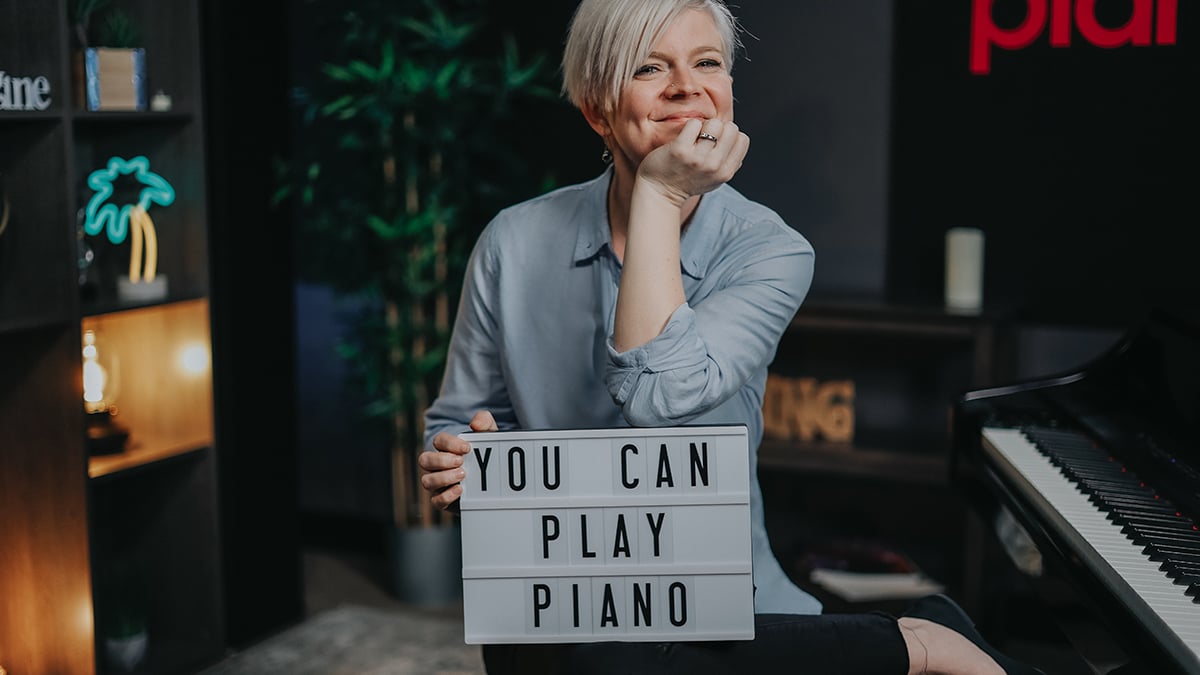
Get started on the right foot (or rather, hand). Get four FREE lessons that will take you from sitting down on the piano for the first time to playing your first song.
To schedule your practice sessions is to think carefully about the best time to practice. And committing to that.
To help you plan and commit, you can use the Pianote Practice Planner or any scheduling tool. What’s most important is being consistent. It’s better to practice 10 minutes a day every day than it is to binge-practice an hour once a month.
Get free lessons, tips, and piano news delivered to your inbox every week. Subscribe to The Note!
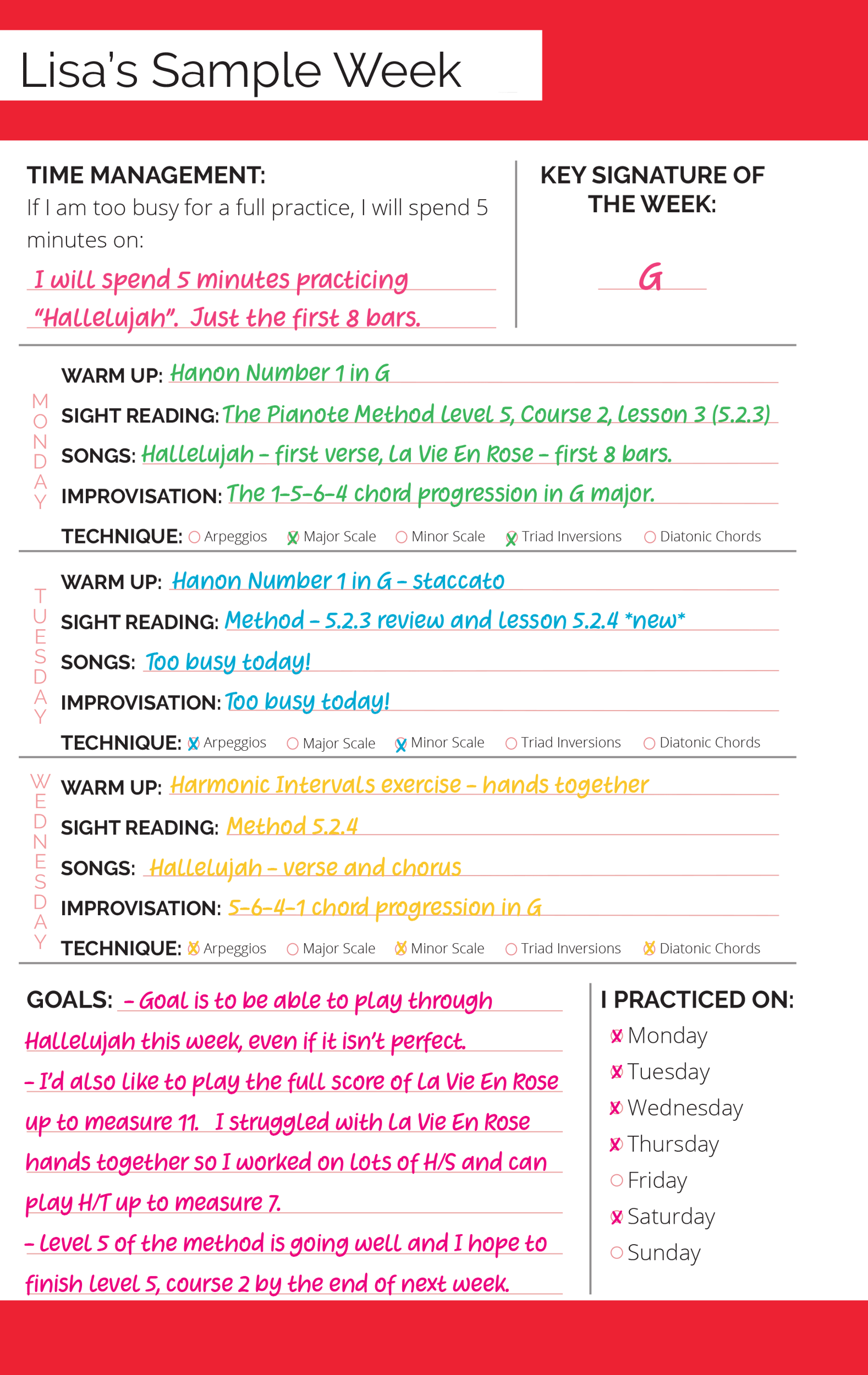
Make the best use of your time. Don’t play the same song over and over from beginning to end. Instead, strategize your practice session for maximum success.
As a beginner, you should focus on three main areas when you practice:
Understanding the layout of the keyboard is fundamental to piano success. And hand coordination is a basic skill that will accompany you for the rest of your piano-playing career.
But don’t forget to practice songs! After all, songs are the reason we play piano in the first place 🙂
And if you’re looking for a strategy, here’s a template you can use…
Here’s a routine we like that targets all those things we just mentioned: keyboard familiarity, hand coordination, and playing songs.
First things first, know your musical alphabet!
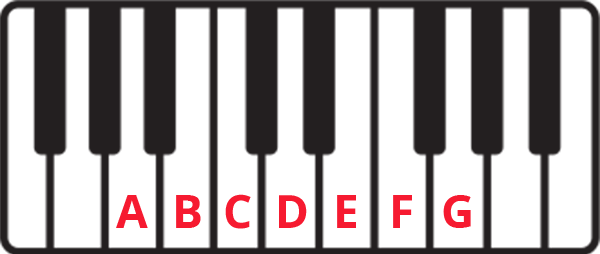
Know it forwards and backwards. You can even pick a letter in the middle, like C, and recite the alphabet backwards and forward to practice.
You can use the black keys to orient yourself too. Notice how there are groups of two and three black keys. These can help you find key notes like C and F.

Now that you know your keyboard geography, test yourself! Name a random note and see how fast you can find it.
Playing with both hands looks simple, but for beginners who are unfamiliar with the moment, it will feel strange and even challenging.
Try this. Put your thumb (finger 1) on Middle C and the rest of your fingers on the keys thereafter.
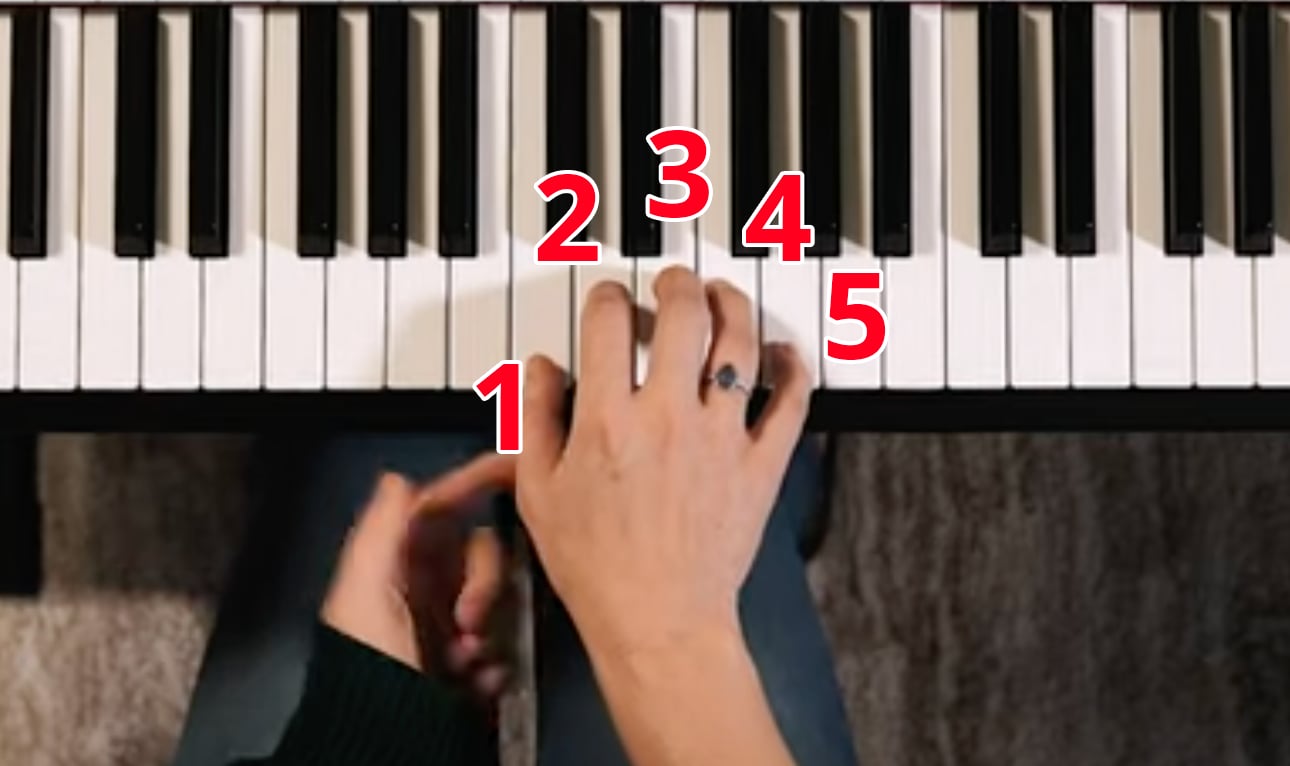
Now, this is important: posture. Your wrists should be up, not drooping, and your fingers should be slightly curved, which is their relaxed position. If you feel tense, try relaxing your shoulders.
Press down on each key and release, one at a time. This LOOKS simple, but if your fingers have never done this before, it’ll feel strange and can even be challenging.
🎹 PERFECT POSTURE AT THE PIANO: Get ergonomic advice from a chiropractor in this lesson.Next, try the same thing with your left hand. Put your pinky finger (finger 5) on the C below Middle C and line up the rest of your fingers with the keys.
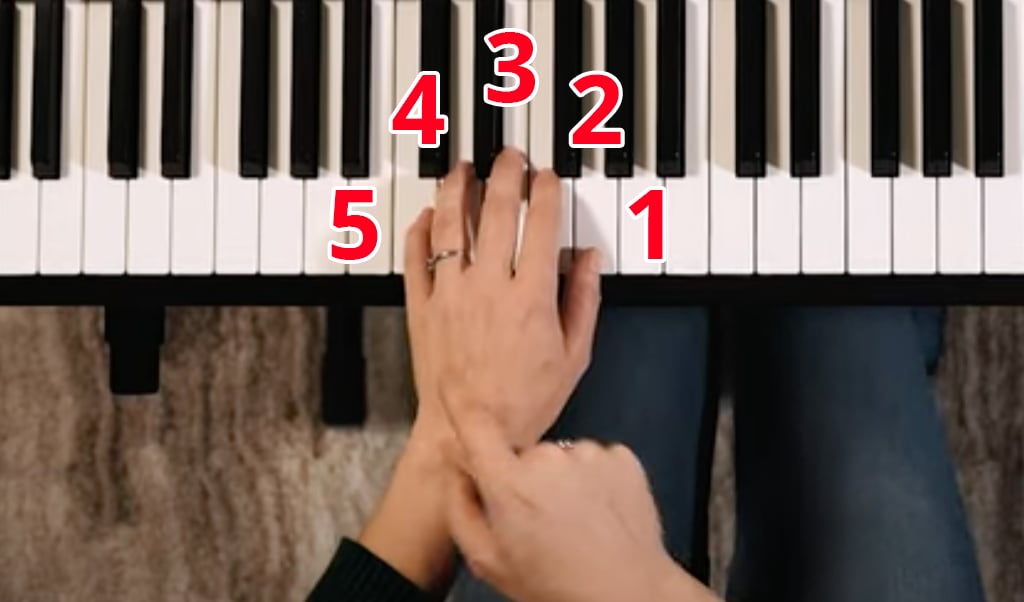
Press the keys one at a time starting with your pinky finger, going up the keyboard. Fingers four and five will feel the oddest because these are our weakest fingers. Your fingers might fly and jerk awkwardly, but that’s a normal part of starting out.
After practicing hands separately, try playing the pattern hands together.
Now, this is important: think in terms of up and down, not 54321 and 12345. If this is hard at first, that’s normal! Hand independence is something you’ll work on throughout your piano playing career.
Finally, don’t forget to practice songs 🙂
In this section, we’ll teach you a common chord progression that forms the basis for hundreds, perhaps thousands of songs. There are only four chords, but you can do so much with these four chords!
This is the progression we’ll use:
I – V – vi – IV
What do these Roman numerals mean?! Well, let’s go through each of the five notes we’ve been playing and assign them each a number.
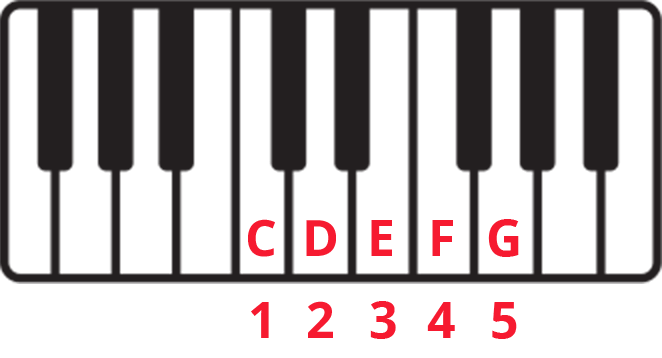
This is what we mean by I-V-vi-IV. We’ll play chords based on the first, fifth, sixth, and fourth chords.
Let’s start with the I. Find and place your thumb on C. Then, play G with your pinky finger, making a fifth. This is a shell chord.
Then, we’ll scooch up so that our thumb is now on the G, and we’ll create a shell chord by playing D with our pinky.
We’ll do the same moving to A and then F. So, in summary, these are the shell chords we’ll play:
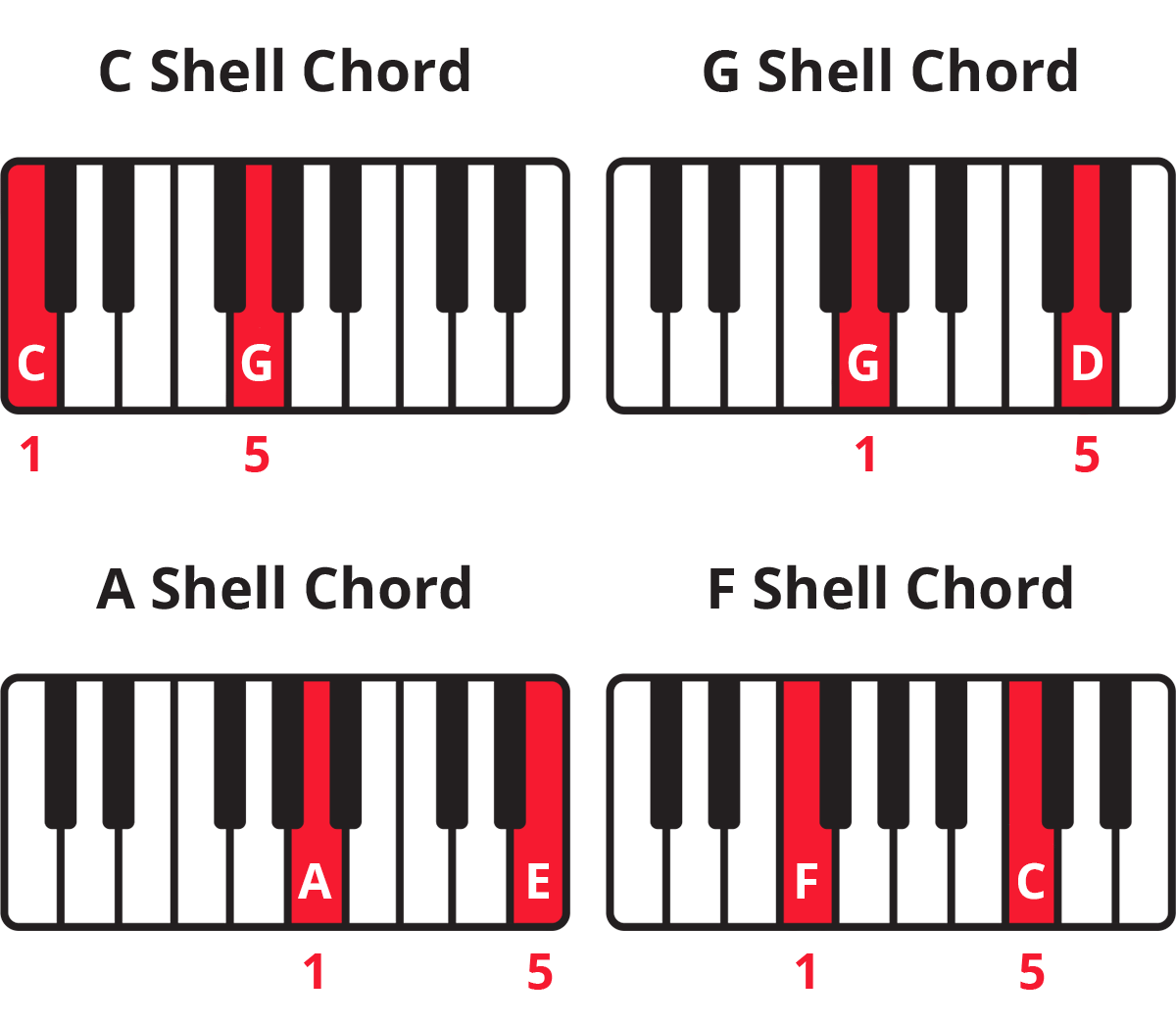
Master these shapes with your right hand. When you’re comfortable, add a bass note with your left by playing the bottom note (root) at the same time as each chord. So your left hand will play:
C – G – A – F
And guess what?
You can play most pop songs now!
These chords underlie some of the biggest songs ever performed. Like “Let It Be” (The Beatles), “Don’t Stop Believin’” (Journey), and “I’m Yours” (Jason Mraz). If you want to learn more about the famous I-V-vi-IV pop progression, check out our lesson here.
🎹 WANT MORE INFO ON CHORDS? Theory isn’t always fun, but understanding diatonic chords, how chord progressions work, and how to decode the number system will set you up for quick success. If you want to dive deeper in these concepts, check out:For a more hands-on approach, check out our free four-lesson series, Chord Hacks.We hope you found these beginner tips helpful! If you would like to learn piano step-by-step from real teachers and be motivated by a warm, supportive community, consider joining Pianote as a Member.
In 2022, we’re also introducing Coaches. Which means that, as a Pianote Member, you can learn from world-class stage pianists like Victoria Theodore (Beyoncé, Stevie Wonder), Erskine Hawkins (Christie Michele, Zendaya), Summer Swee-Singh (Bebe Rexha, Circa Survive), and more.
And if you’re not ready for all that yet, no problem! Check out Getting Started on the Piano, a free course on how to play piano.
Lisa Witt has been teaching piano for more than 20 years and in that time has helped hundreds of students learn to play the songs they love. Lisa received classical piano training through the Royal Conservatory of Music, but she has since embraced popular music and playing by ear in order to accompany herself and others. Learn more about Lisa.
/marketing/pianote/promos/april/banner-bg-m.webp)
We use cookies for traffic data and advertising. Cookie Policy »
/marketing/pianote/promos/april/banner-title.webp)